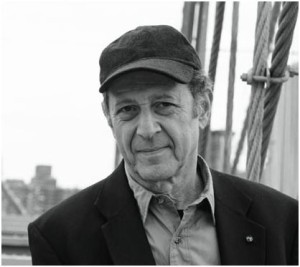Steve Beauchampé has been to see Steve Reich in action. Here’s his review of the 6th March concert.
This has to be one of the highlights of Birmingham’s musical year. Not only is Steve Reich, widely considered the most important living classical composer, making only his third appearance in Birmingham, he’s here to première a major new work. Radio Re-write received its world premier only the night before at the Royal Festival Hall in London, and now a packed Town Hall awaits its chance to hear and assess 76-year old Reich’s latest opus. Rather than a set of variations the piece fuses the chord shapes, cadences, time signatures, and snatches of melody and harmony, from Radiohead songs Everything In Its Right Place (2000) and Jigsaw Falling Into Place (2007) with Reich’s revolutionary minimalist musical idiom.
As a bonus (and what a bonus!), Reich takes part in a pre-concert Q and A, having spent part of the afternoon giving local music students a Master Class. Let’s put these ‘add-ons’ into context; this is akin to being taught painting by Pablo Picasso or Georges Braque, or sitting in the audience whilst J.S. Bach or Bob Dylan discuss their writing technique. No wonder even the pre-concert appearance is a must-see event, with the multi-generational audience audibly and visibly excited to be in Reich’s presence. His appreciation of classical music history, orchestral development and his critique of the divergent paths taken by early twentieth century music (essentially Stravinsky vs. Schoenberg), and how listening to be-bop rather than Stockhausen shaped his own music, were worth the price of admission alone.
Tonight’s opening piece is Clapping Music (1971), performed by just the four hands of Reich and David Hockings, chief percussionist with the London Sinfonietta. An early example of Reich’s phasing technique, it consists of a rhythmic pattern of twelve pulses which one player maintains throughout, whilst the other jumps forward one pulse at a time until, having completed a cycle, they eventually return to the starting point. It’s quite a footapper in places but requires considerable concentration from the performers (and hopefully with no audience distractions such as coughs or sneezes), as there really is nowhere to hide should either player make an error. I’ve heard the work performed on numerous occasions and it strikes me how the differing clapping style of each performer (soft, hard, number of digits used etc) considerably affects the listening experience. For the performers however, to listen to their collaborator (who must stand a mere foot or so away) would be suicidal, a sure way of inducing errors, but one which Reich and Hockings are certainly not prey to tonight.
Reich retreats to the mixing desk for the rest of the performance, starting with Electric Counterpoint (1987). Comprising three movements, it tonight features the ‘live’ guitar of Mats Bergstrom (employing his 1960 Gibson) against a pre-recorded tape of ten guitars, the levels of which Reich controls and manipulates. Bergstrom needs to play with absolute precision, and the piece, though not amongst my favourites from Reich’s career, contains several delightful electronically phased progressions, which Bergstrom responds to admirably.
The first half closes with 2×5 (2008), which Reich composed for the New York-based Bang on a Can collective. Written for rock instruments (four electric guitars, a brace of bass guitars, two drums and two pianos), it can either be played half live/half pre-recorded, or (as tonight) with all ten players (members of the London Sinfonietta) on stage. Reich describes the piece as “chamber music for rock instruments” and the work is completely notated whichever method of performance is employed. As witnessed tonight, it’s an exciting number, largely driven by pianos and basses and amongst the best of Reich’s later compositions. The middle section is more percussive, with the electric guitars becoming ever more dissonant and deranged, before this long period of intensity gives way to the piano-controlled final movement. Having drifted apart (as the phasing element requires), the players reunite following a most intriguing and satisfying trip. It is a measure of the breadth of musical skill required by contemporary classical players of the London Sinfonietta’s standard, that they can light up such a work like 2×5 with such style and perform it with such aplomb.
And so to Radio Re-write: again featuring players from the London Sinfonietta, the orchestra, conducted by Bradley Lubman, comprises four strings, two pianos, vibraphone, flute, clarinet and bass guitar. No recordings, no multi-tracking, the work is played live, balanced by Reich at the mixing desk. Those looking for recognisable snippets of Radiohead will find mere glimpses (Everything In It’s Right Place in the two slow movements, Jigsaw Falling Into Place in the two fast ones), rather than a translation of their work into minimalism. But that is not where the disappointment lies; whilst the strident piano and vibraphone opening bodes well, the slow movements meander unappealingly, contributing to an overall lack of sustained intensity, excitement and the absence of the bright optimistic tone so prevalent in much of Reich’s work. No alarms and no surprises, as it were and I was not persuaded.
Closing the performance is Double Sextet (2008) a three-movement work normally performed by six musicians reacting against a multi-track tape of themselves. Tonight however, there are 12 ‘live’ Sinfonietta musicians, comprising a brace of pianos, marimbas, flutes, clarinets, cellos and violins. The route is essentially dictated by the pianos, with exploration of the by-roads primarily the provenance of the strings. The movements are best described as urgent, slow, urgent, with an overall coherence and feeling of purpose to the work, a sense of the instrumentation working together rather than fighting for territory. A fine ending to an at times scintillating evening.
As rich applause rings out, Steve Reich makes his way from the mixing desk to the stage to acknowledge the cheers. It is to be hoped that he will return to the region at least once more.



